NREL Celebrates Another Year of Groundbreaking Research
The Laboratory’s Top 20 Stories From 2024
The U.S. Department of Energy’s (DOE’s) National Renewable Energy Laboratory (NREL) has been dedicated to advancing energy for a brighter future since its inception as the Solar Energy Research Institute in 1977. And each year, the laboratory has continued to expand, and its research has continued to propel the world forward.
2024 was no different: The following 20 stories highlight some of the laboratory’s most impactful moments from the past year.
How Extreme Weather and System Aging Affect the US Photovoltaic Fleet
For solar photovoltaic (PV) systems—designed to operate over lifetimes of 20, 30, or even 50 years—small losses in energy production can add up to measurable differences over time. These differences can even determine whether a system operates at a profit or loss. Yet, small changes in energy production are frustratingly difficult to measure, especially in the noisy and often incomplete data of a PV system's production.
After four years of work, NREL researchers have compiled a data set from an unprecedented number of PV systems across the United States—data streams from 25,000 inverters across almost 2,500 commercial- and utility-scale PV sites in 37 states and U.S. territories. By cleaning and averaging data from a huge set of systems, the PV Fleet Performance Data Initiative (PV Fleet) offers a clearer-than-ever look at the health of the U.S. PV fleet and reveals some of the factors that are impacting its performance.
How Can We Detect Hail or Wind Damage in Fielded PV Modules?
Watch how the Durable Module Materials Consortium is testing a new, low-cost approach
in the middle of the night.
On the Ground in Colorado, NREL Is Simulating Sustainable Aviation Fuel Combustion During Flight
Changes are coming for jet fuel, and the aviation industry is actively inviting them. Like changes to gasoline and diesel chemistry in the past, adopting sustainable aviation fuel (SAF)—an energy-dense, renewable fuel seen as essential for flight—means proving the fuel is as safe and reliable as the old stuff, as well as being fully compatible with existing jet engines.
Computational science and fuels-and-combustion researchers at NREL have teamed up to gather meticulous fuel chemistry data to equip the industry with an ultra-detailed SAF combustion simulation. Powered by supercomputers, the "virtual jet engine" can predict how SAF performs during flight and provide insights on how to tune it to maximize its safety and performance. If successful, the SAF research platform might reveal insights that could help planes fly farther, run , and perform better than ever before.
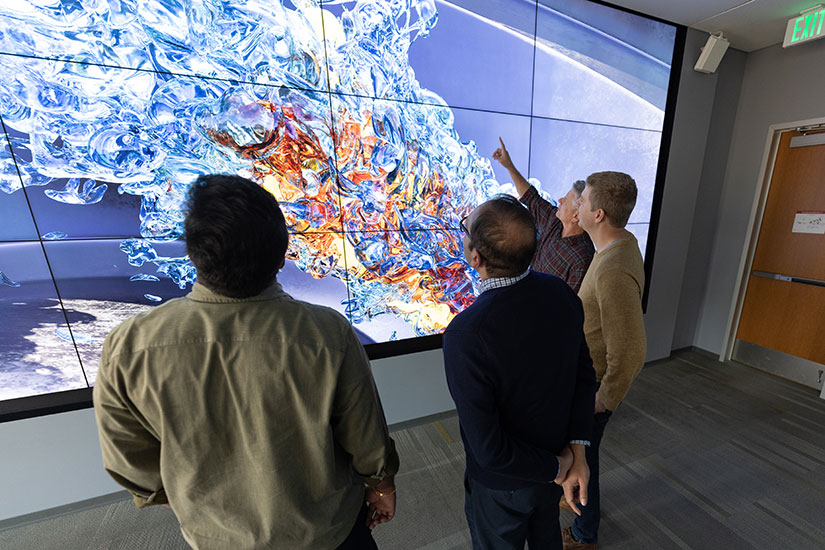
Can Ocean Energy Power Carbon Removal?
Feb. 1
Atop the Caribbean Sea’s famously pristine waters floats a 5,000-mile-wide heap of
rust-colored, brambly seaweed. When that seaweed, a form of sargassum, clumps up on
beaches and decomposes, it emits hydrogen sulfide gas (also known as swamp gas), which
smells like rotten eggs and, in high doses, can be toxic. But this stinky seaweed
could also be part of a solution.
“If you sink that seaweed into the deep sea, you can potentially avoid those issues,” James Niffenegger said. “And with seaweed sinking, the deeper you go, the longer you can store the carbon dioxide it absorbed from the air and water.”
Niffenegger, a researcher at NREL, is an author of a new study that examined various methods to capture carbon dioxide from the air or ocean and permanently sequester or store it—or, better yet, do both simultaneously. Some techniques involve farming or sinking seaweed, others inject captured carbon into deep-sea rocks, and some capitalize on clever chemistry to remove carbon directly from the ocean. But almost all are relatively new and untested technologies, and their costs, environmental impacts, and potential efficacy are still largely unstudied. Until now.
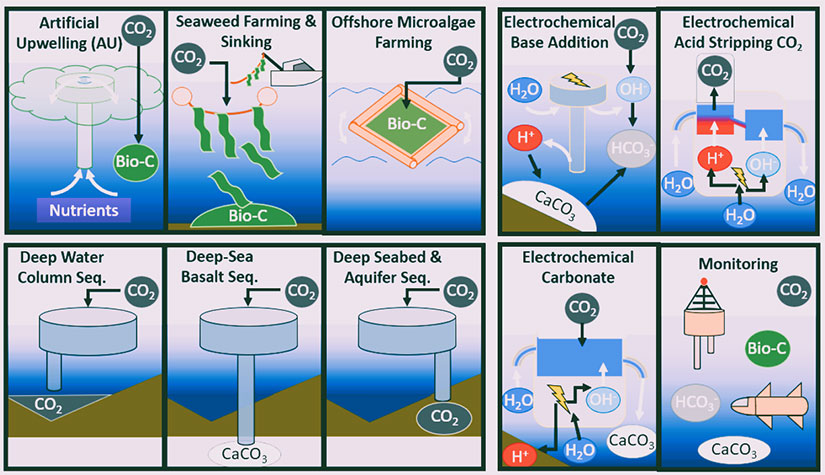
The team examined many marine carbon management methods, including marine carbon capture, which separates carbon dioxide from the air or ocean; sequestration, which permanently stores that captured carbon; and removal, which does both. None are faultless. Illustrations by James Niffenegger, NREL
Benefits of Heat Pumps Detailed in New NREL Report
Feb. 12
Millions of U.S. households would benefit from heat pumps, but the cost of installing
the technology needs to come down to make their use a more attractive proposition,
according to researchers at NREL. The findings, detailed in the journal Joule, quantify the costs and benefits of air-source heat pumps across the United States
and consider various climates, heating sources, and types of homes. The researchers
based their conclusions on simulations of 550,000 statistically representative households.
Their analysis considered such factors as the performance of different heat pumps and whether additional steps to upgrade the insulation had occurred. The analysis revealed a majority of Americans (62% to 95% of households, depending upon heat pump efficiency) would see a drop in their energy bills by using a heat pump. Improving the weatherization of a home, such as by installing better insulation, would increase the range to 82% to 97%. However, due to high installation costs, heat pumps may only be financially feasible for a smaller portion of households.
Unleashing the Power: BatMan Project Revolutionizes Battery Manufacturing
Feb. 13
Gotham City’s Dark Knight boasts an impressive collection of technological marvels,
but the superhero scientists at NREL have cutting-edge capabilities of their own.
A recent battery manufacturing project—affectionately called BatMan—has developed
a novel laser patterning process to alter the microstructure of battery electrode
materials. This revolutionized manufacturing process could unlock significant improvements
to electrified transportation, leading the charge toward a brighter and more sustainable
future.
“BatMan builds on NREL’s expertise using laser ablation, advanced computational models, and materials characterization to address key challenges in battery manufacturing,” said Bertrand Tremolet de Villers, project co-lead and senior scientist in NREL’s Thin Film and Manufacturing Sciences group. “This new, high-throughput laser patterning process—demonstrated at scale with state-of-the-art roll-to-roll manufacturing techniques—uses laser pulses to quickly and precisely modify and optimize electrode structures, offering a massive leap in battery capabilities with minimal added manufacturing cost.”

From left to right, Donal Finegan, Bertan Özdoğru, and Bertrand Tremolet de Villers celebrate the successful demonstration of BatMan’s novel laser-patterning process, which alters the microstructure of battery electrode materials to improve battery performance. Photo by Donal Finegan, NREL
NREL Collaborates on $15 Million Multilaboratory Efforts To Advance Commercialization of Carbon Dioxide Removal
Feb. 13
DOE tapped NREL to support a new $15 million research effort to improve the measurement,
reporting, and verification (MRV) of carbon dioxide (CO2) removal technologies. This newly emerging and rapidly expanding industry has the
potential to address existing carbon emissions and remove them from the atmosphere.
To achieve this goal, scientists must first establish robust scientific frameworks
and methodologies to account for these efforts—giving governments and private buyers
a unified approach to tracking the of their investments.
Equipped with years of industrial carbon management, CO2 removal, and carbon capture utilization and storage expertise, NREL will lead two of the four winning proposals and collaborate on a third led by Lawrence Livermore National Laboratory. The projects seek to offer leadership in the MRV process by integrating engineering, chemical, geophysical, modeling, and community-centered MRV frameworks into a unified collection of guidelines.
Clean Bus Planning Awards Support Fleet Electrification With Custom Transition Plans
Feb. 20
Transit and school bus fleets across the nation are working hard to incorporate advanced
transportation solutions that help communities meet carbon management goals and improve
local health outcomes. However, planning for and deploying zero-emission fleets is
a tall order, leaving many fleet managers with more questions than answers.
To help solve the problem, NREL announced the $5 million Clean Bus Planning Awards (CBPA) program, which is funded by the Joint Office of Energy and Transportation. Managed by NREL, the CBPA program provides free technical assistance to create comprehensive and customized bus electrification plans for school and transit fleets across the United States through Fiscal Year 2024.
On Its Journey To Make Clothing That Leaves No Trace, The North Face Taps the BOTTLE Consortium To Scale Biodegradable Polyester Alternative
Feb. 29
By some estimates, fibers from polyester clothing account for nearly half of all microplastics
in the natural environment, exacerbating a growing environmental and public health
hazard. Preventing clothes from shedding may be impractical, if not impossible. But
according to Katrina Knauer, an NREL polymer scientist and chief technology officer
of the U.S. Department of Energy’s Bio-Optimized Technologies to keep Thermoplastics
out of Landfills and the Environment (BOTTLE) consortium, a better solution is emerging
that could address the challenge at its source: replace today’s petroleum-derived
polyester with a nontoxic, biodegradable alternative made from PHAs, short for “polyhydroxyalkanoates.”
Already, BOTTLE scientists—including a team from NREL and Colorado State University—have developed a portfolio of PHAs with different properties, including some that behave like conventional polyester but are biobased, biodegradable, and easier to recycle. Now, in conjunction with The North Face, that team is bringing those sustainable materials into the outdoor apparel industry. BOTTLE is scaling the process to produce several pounds of PHA fiber, which The North Face will test and evaluate for use in its product lines.
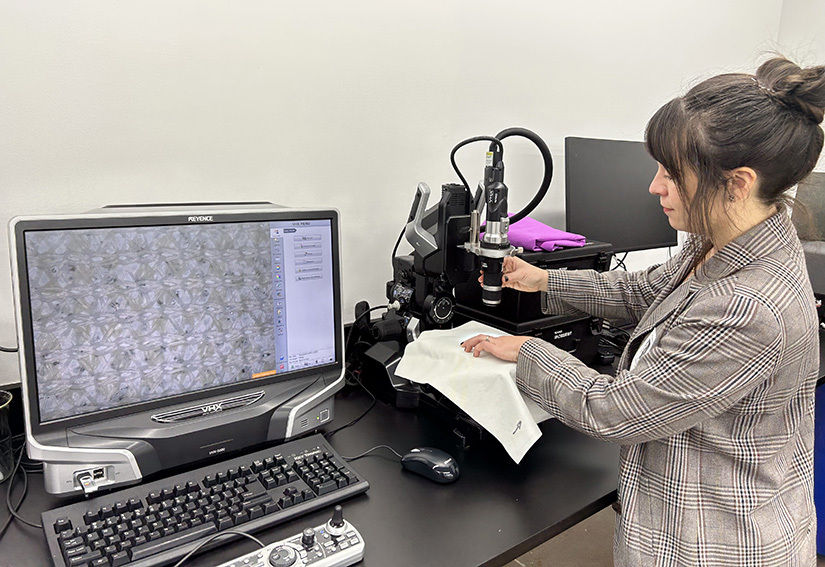
NREL Scientist Kat Knauer examines a waterproof, breathable textile using optical microscopy at The North Face’s Denver, Colorado, laboratories. Photo by Julie Thompson
How Many Transformers Will US Distribution Grid Need by 2050?
March 4
The United States is currently experiencing unprecedented imbalance between supply
and demand for transformers. Similar to how a traffic cop manages the flow of vehicles
on a road, distribution transformers manage the flow of electricity along the power
grid by changing high-voltage electricity from transmission lines into low-voltage
electricity before it reaches consumers. The demand increase is largely driven by
aging transformers and electrification.
To get ahead of the increasing demand, NREL researcher Killian McKenna and his team are leading an effort to quantify the long-term demand for distribution transformers. NREL completed the first phase of the study that quantified the number, capacity, age, and use of the nation's current transformer stock—something that has never been done before. Based on the transformer data collected, NREL estimates distribution transformer capacity may need to increase 160%–260% by 2050 compared to 2021 levels to meet residential, commercial, industrial, and transportation energy demands.
Solution to Energy Storage May Be Beneath Your Feet
March 28
Anyone who has ever hot-footed it barefoot across the beach on a sunny day walks away
with a greater understanding of just how much heat sand can retain. That ability is
expected to play a vital role in the future, as technology involving heated sand becomes
part of the answer to energy storage needs. Batteries are likely what most people
think about in terms of storing energy for later use, but other technologies exist.
One approach relies on what is known as thermal energy storage, or TES, which uses molten salt or even superheated rocks. TES shows promise as a low-cost alternative to existing storage technologies, and storing energy in solid particles such as sand provides a ready answer, without geological restrictions. After all, sand, like air and water, is everywhere.
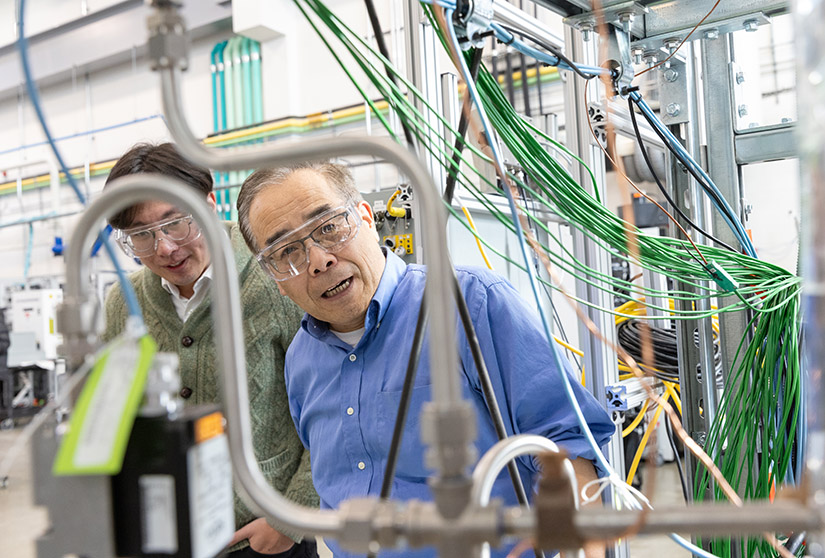
Researchers Shin Young Jeong and Zhiwen Ma examine the prototype device that uses superheated sand for long-duration energy storage. Photo by Joe DelNero, NREL
Puerto Rico Can Reach Its 100% Renewable Energy Goal by 2050
April 8
Puerto Rico hit a deadly record in 2017, when back-to-back hurricanes destroyed around
80% of the island's electric grid. This was the longest blackout in U.S. history—taking
328 days to get power fully restored—and resulted in more than 3,000 lives lost.
In the face of these challenges, the people of Puerto Rico want to rebuild differently. In 2019, they passed Act 17, committing to reach a 100% renewable energy system by 2050. With billions of dollars in funding, the question is where and how to invest, while remaining true to their values and priorities. The Puerto Rico Grid Resilience and Transitions to 100% Renewable Energy Study (PR100) is a two-year study that leveraged and integrated dozens of best-in-class models and in-depth analyses from researchers across six DOE national laboratories, led by NREL.
NREL Shows Live Grid Impacts From Total Solar Eclipse
April 8
On April 8, 2024, a total solar eclipse traversed North America bringing a period
of midday complete darkness to 12 U.S. states and affecting solar power plants across all 50 U.S. states. The DOE Solar Energy Technologies
Office, NREL, and the North American Electric Reliability Corporation partnered to
evaluate the grid impacts of the eclipse.
An NREL livestream during the eclipse looked at how the power grid is impacted by the loss of solar generation and how that reduction of generation is managed at the regional and interconnection levels. Viewers saw exactly what the NREL control room was seeing in near real time, including current information from independent system operators such as current generation mix and changing energy demand as the eclipse traversed the country.
An NREL livestream during the eclipse looked at how the power grid is impacted by the loss of solar generation and how that reduction of generation is managed at the regional and interconnection levels. Viewers saw exactly what the NREL control room was seeing in near real time, including current information from independent system operators such as current generation mix and changing energy demand as the eclipse traversed the country. The livestream coverage ran for the entirety of the eclipse.
This animation shows the expected loss of solar generation as the eclipse traverses a map of the United States.
The (In)Visible Plastic Pollution Problem
April 18
A harmful substance is making its way down rivers and into oceans around the world: plastic debris. In the United States, more than a million tons of plastic debris enters ocean-bound rivers, creeks, and sewer drains every year. Today’s waterborne plastics debris consists mostly of discarded textiles, electronics, construction materials, single-use packaging, and other waste. The result is a complex plastic pollution problem with broad scope, significant challenges, and emerging solutions.
The Waterborne Plastics Assessment and Collection Technologies (WaterPACT) project led by NREL is on a mission to develop renewable-energy-powered technologies to detect, quantify, and collect plastic from U.S. waterways. With collaboration from researchers at the Pacific Northwest National Laboratory, the NREL-led Bio-Optimized Technologies to keep Thermoplastics out of Landfills and the Environment (BOTTLE) consortium, and the Environmental Molecular Sciences Laboratory, the WaterPACT project aims to reduce the volume of plastic currently entering the ocean annually via U.S. waterways by more than half by 2040.
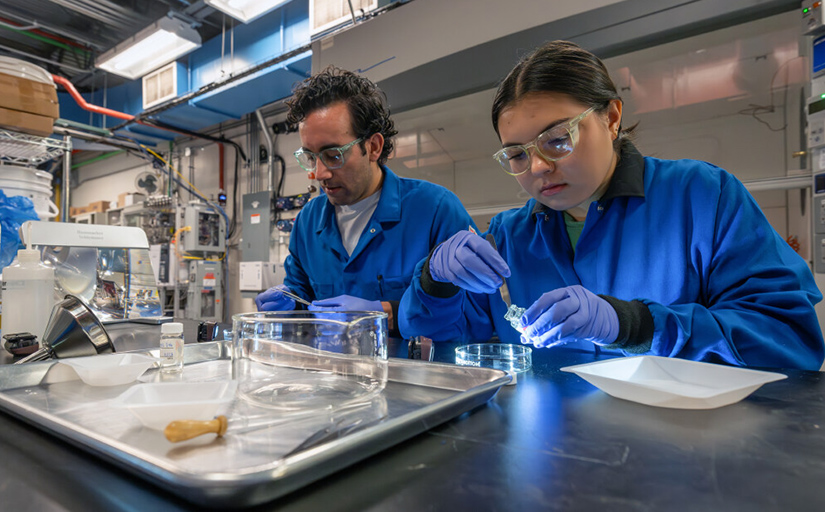
How To Realize the Maximum Value of Interregional Transmission
June 4
Interregional transmission—lines that connect multiple planning regions—can provide
many benefits to electric customers, but market and operating practices were not necessarily
designed for this type of interconnected system.
“As we build up our interregional transmission systems, we need to take a fresh look at improving the efficiency and efficacy of the existing system, which could increase grid reliability while reducing cost,” said Christina Simeone, a grid researcher at NREL.
A new NREL report led by Simeone, Barriers and Opportunities To Realize the System Value of Interregional Transmission, examines issues that prevent existing transmission facilities from delivering maximum potential value and offers a suite of options that power-system stakeholders can pursue to overcome those challenges. The report groups barriers and opportunities for interregional transmission among all regions, between non-market or a mix of market and non-market areas, and between market areas.
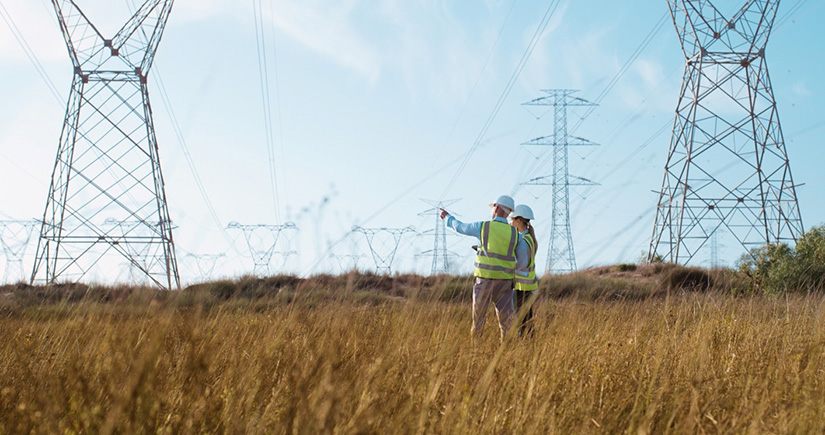
How To Power the South Pole With Renewable Energy Technologies
June 20
Researchers at two U.S. Department of Energy laboratories—NREL and Argonne National
Laboratory—looked at how a combination of solar modules, wind turbines, and battery
storage could provide a cost-effective way to expand research capabilities at the
South Pole while significantly reducing costs. The idea to shift away from diesel
fuel specially formulated to withstand the extreme cold comes as scientists look toward
future experiments. The new paper calculates the levelized cost of energy for powering
the South Pole amounts to $4.09 a kilowatt-hour (kWh) for diesel fuel, compared to
33 cents for wind and 23 cents for solar.
Using the NREL-developed Renewable Energy Integration and Optimization (REopt) tool, which calculates the economic viability of a renewable project, the researchers determined the least-cost scenario to supply a consistent 170 kW of power for new research equipment at the South Pole involves a hybrid system involving six wind turbines, 180 kilowatts of solar, and 3.4 megawatt-hours of battery energy storage. That combination reduces the amount of diesel power consumption by 96%, reducing the need to transport fuel to the South Pole and the subsequent environmental damage of burning that fuel in such a pristine location.
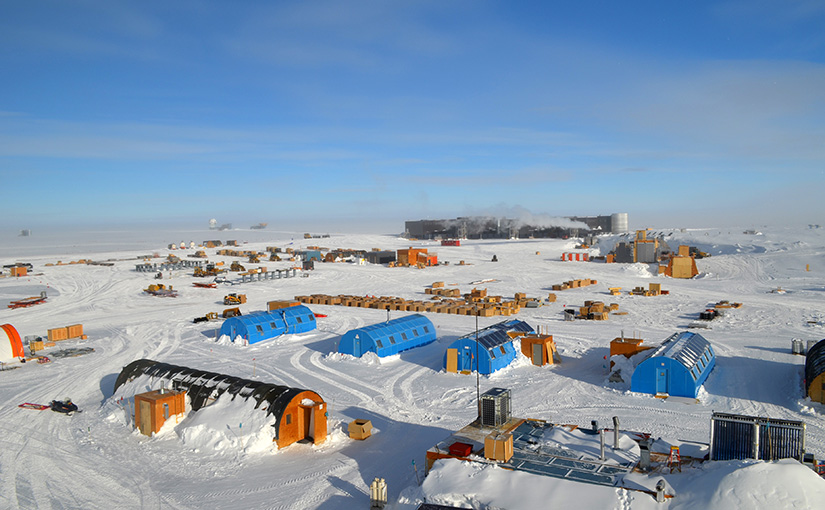
The backyard of Amundsen-Scott South Pole Station contains work-center buildings and cargo-staging areas. The main station is the large gray building in the distance. To the left of center in the distance, several of the scientific telescope buildings can be seen. Photo by Ian McEwen, National Science Foundation
Offshore Wind Turbines Offer Path for Clean Hydrogen Production
July 11
Using electricity generated by offshore wind turbines as one pathway to split water
to produce hydrogen may make economic sense, particularly along the U.S. Atlantic
Coast and in the Gulf of Mexico, according to researchers at NREL. The economics work
best in regions where the water is not as deep and the wind is strong, according to
their findings in the recently published article, “Potential for large-scale deployment of offshore wind-to-hydrogen systems in the United
States,” which appears in the Journal of Physics: Conference Series.
The paper describes the use of case study simulations to analyze the techno-economics of producing hydrogen from offshore wind energy in 2025, 2030, and 2035. NREL researchers evaluated two scenarios relying on electrolysis powered by offshore wind and identified four representative coastal areas for wind-to-hydrogen hybrid facilities.
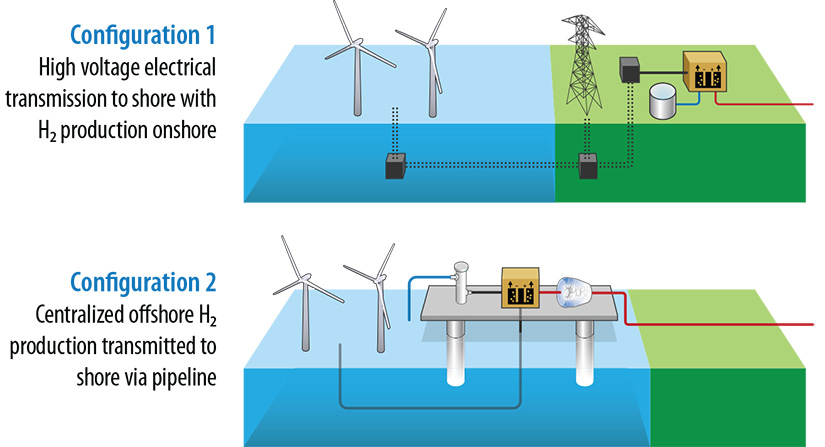
Two different configurations were studied for generating hydrogen using offshore wind. Illustration by Alfred Hicks, NREL
Decades of NREL Research Power Electric Vehicle Revolution Progress
July 30
Charging stations must be widespread and reliable to entice motorists to make the
switch to an electric vehicle (EV) as their primary mode of transportation, according
to Eric Wood, a senior EV charging infrastructure researcher at NREL. This was a key
finding from NREL’s 2030 National Charging Network: Estimating U.S. Light-Duty Demand for Electric Vehicle
Charging Infrastructure report, which Wood coauthored.
The analysis points to the need for a mix of publicly accessible charging stations along highways and near homes and workplaces and private charging ports at single-family homes, apartments, and offices. The scenario also calls for fast-charging stations available to the public and slower charging in private homes where speed is not of the essence.
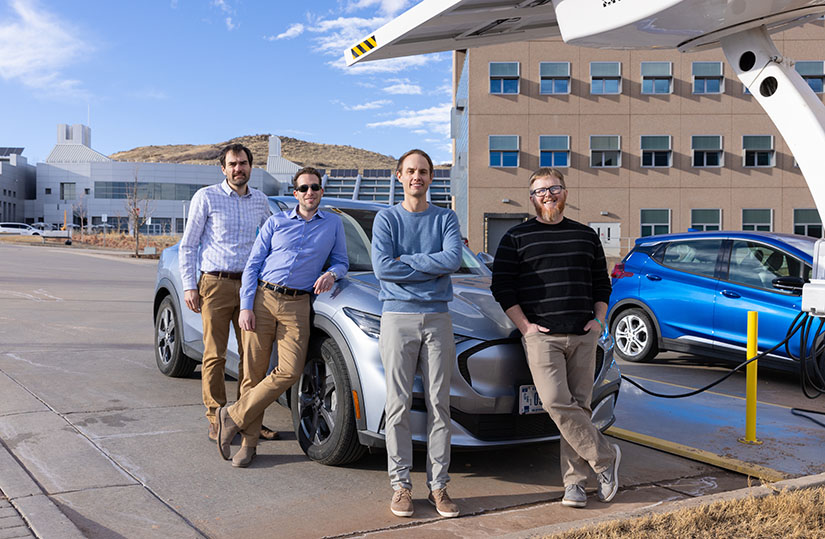
NREL researchers (from left) Andrew Meintz, Matteo Muratori, Brennan Borlaug, and Eric Wood all work in the field of electric vehicles. Photo by Joe DelNero, NREL
NREL Advances Method for Recyclable Wind Turbine Blades
Aug. 22
Researchers at NREL see a realistic path forward to the manufacture of bio-derivable
wind blades that can be chemically recycled and the components reused, ending the
practice of old blades winding up in landfills at the end of their useful life. The
new resin, which is made of materials produced using bio-derivable resources, performs
on par with the current industry standard of blades made from a thermoset resin and
outperforms certain thermoplastic resins intended to be recyclable.
The researchers built a prototype 9-meter blade to demonstrate the manufacturability of an NREL-developed biomass-derivable resin nicknamed PECAN. The acronym stands for PolyEster Covalently Adaptable Network, and the manufacturing process dovetails with current methods. Under existing technology, wind blades last about 20 years, and afterward they can be mechanically recycled such as shredded for use as concrete filler. PECAN marks a leap forward because of the ability to recycle the blades using mild chemical processes.

An NREL scientist holds small cubes of the PECAN resin. Photo by Werner Slocum, NREL
National Transmission Analysis Maps Next Chapter of US Grid Evolution
Oct. 3
The U.S. power grid has been called one of the greatest—and largest—engineering marvels
of the 20th century. Made up of more than half a million miles of transmission lines,
it delivers power to 160 million customers every day. But the nation's electric grid
will have to grow even larger to enable an affordable, sustainable, and reliable energy
future. And planners and developers need a better understanding of how the nation's
current transmission system must evolve to break free of its current gridlock.
The newly released, multiyear National Transmission Planning (NTP) Study identifies transmission solutions that can help revamp the U.S. power grid to support the next generation of transmission needs and provide broadscale benefits to electric customers. The NTP Study examined the nation's large and complex transmission system through innovative methods including several interlinked models and state-of-the-art practices. A holistic approach enabled expansive insights about large-scale transmission improvement options across the nation—and at the level of detail needed for rigorous planning. With the key principles of least-cost planning and power system reliability, the researchers modeled nearly 100 future scenarios through 2050 to examine uncertainties and identify robust regional and interregional transmission opportunities.
Year 2035 Projections
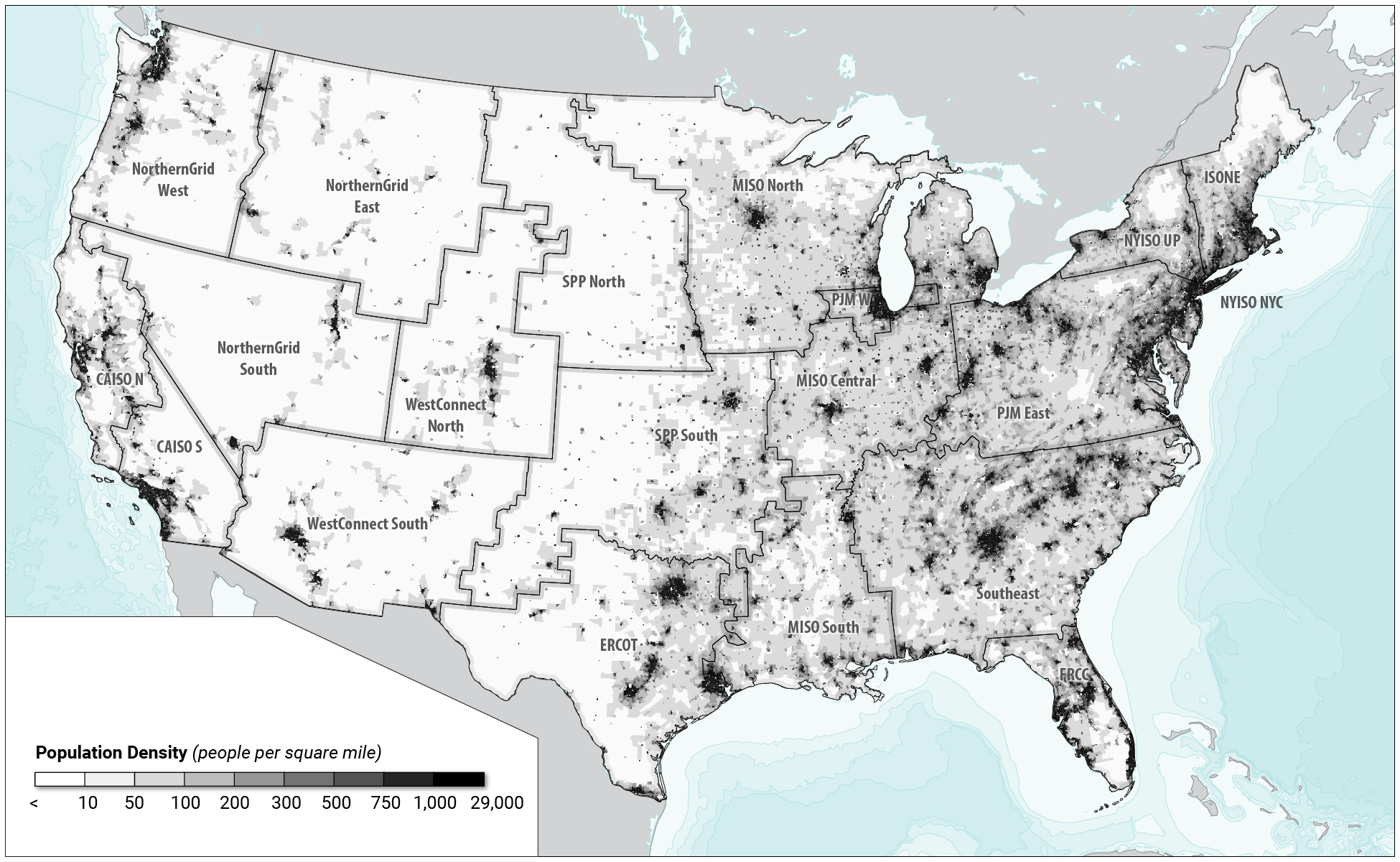
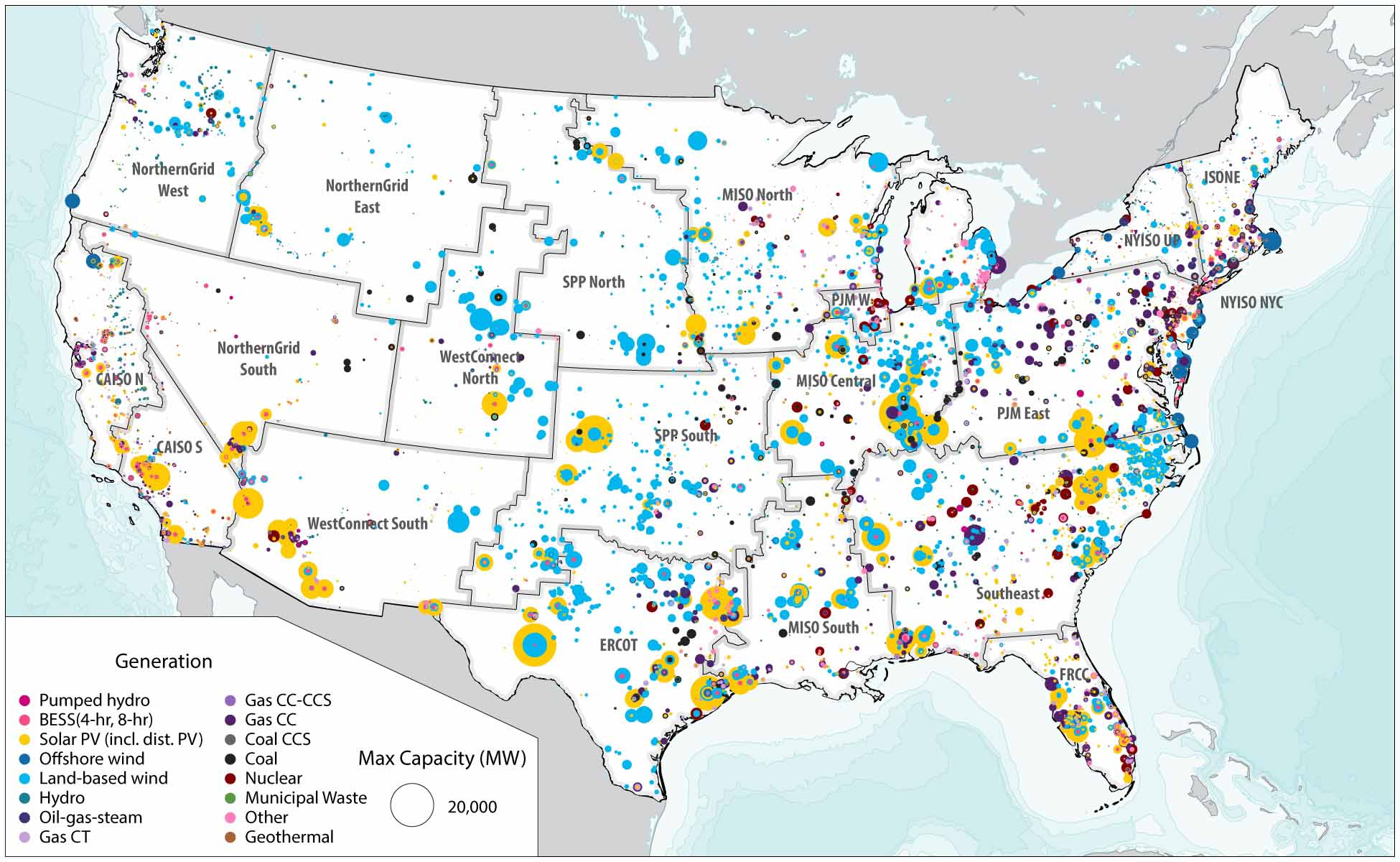
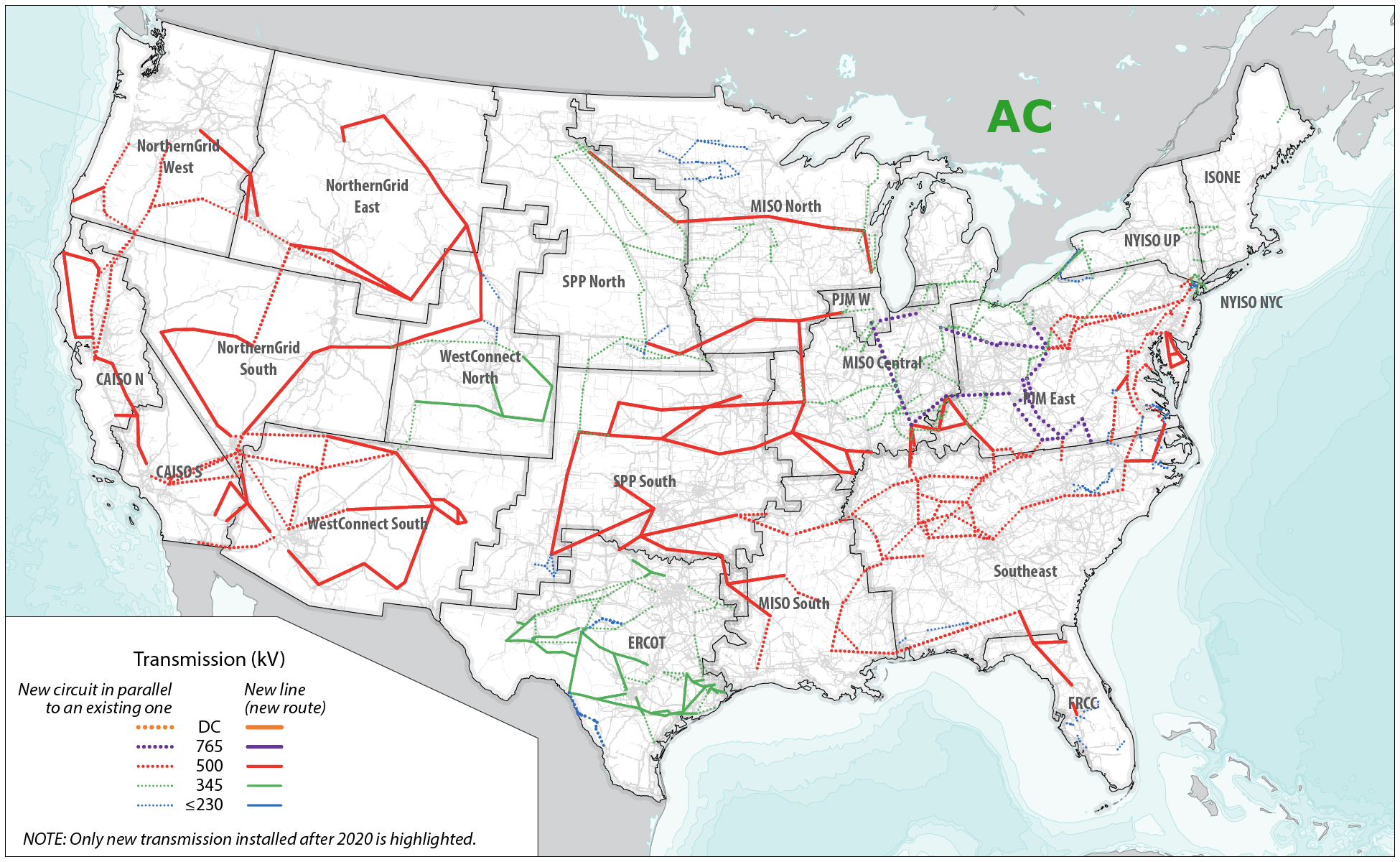
The study team performed nodal analysis of U.S. transmission expansion scenarios, providing valuable insights into potential challenges that could arise as planners and operators manage large-scale transitions. Graphic by Billy Roberts, NREL
Lighting the Way for Agrivoltaics: How NREL Empowers Communities To Capture the Benefits of Solar Energy, Agriculture, and Ecosystems
Nov. 21
With their reflective, smooth glass sheen, stiff metal posts, and electric wiring, you might be surprised to learn that solar fields can be sites of thriving biodiversity, regenerative agriculture, and community bonding. Three years ago, when representatives from NREL first started talking with Josie Hart—a farmer and the associate director of Farm Programs for the Denver Botanic Gardens—she could not have imagined what was possible as a farmer on a solar site.
"I tried to picture a solar field, and I just saw miles of solar panels low to the ground," Hart said. "But I learned a lot from NREL researchers about how solar installations can be used to enhance farming and that it’s not just about the solar panels—it’s about the mutual benefits of colocating solar with farming."
Agrivoltaics is the practice of bringing together agricultural activities and photovoltaics—using the same land to harvest solar energy and reap agricultural benefits, like grazing, crop production, increased pollinator habitat, and soil health. The Denver Botanic Gardens now boasts a new 1.2-MW, 4.5-acre agrivoltaics facility at its Chatfield Farms locations, which is a 700-acre native plant refuge and working farm about 20 miles southwest of downtown Denver, Colorado.
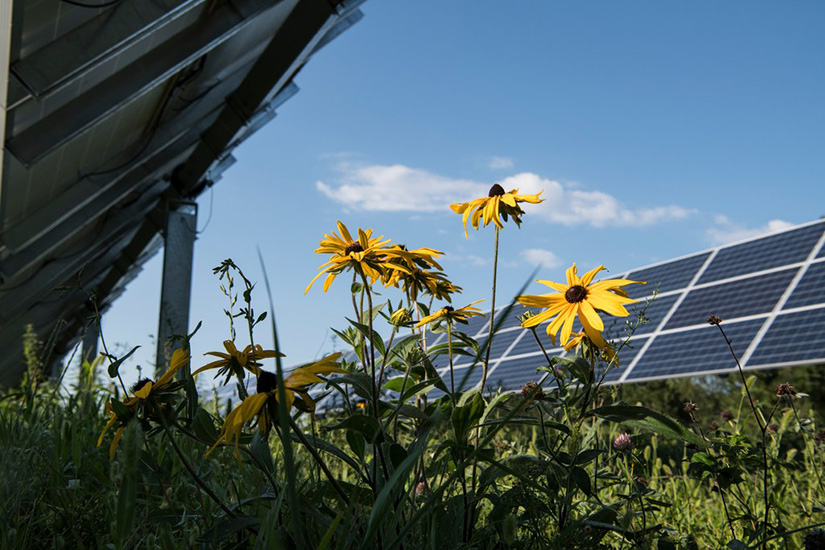
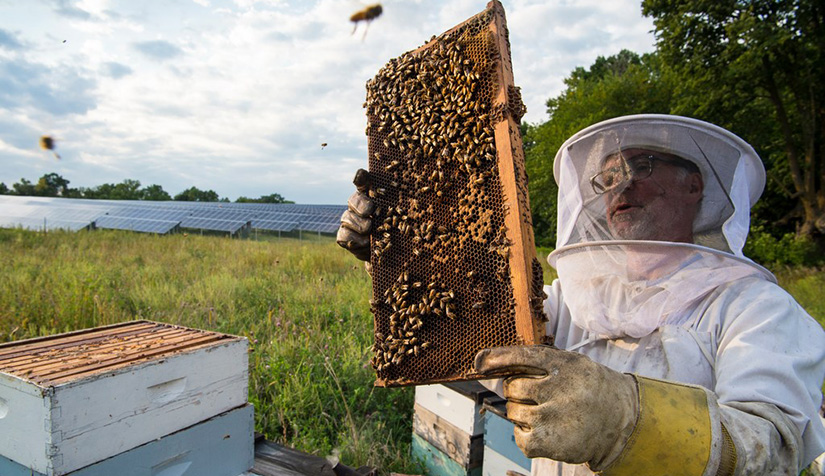
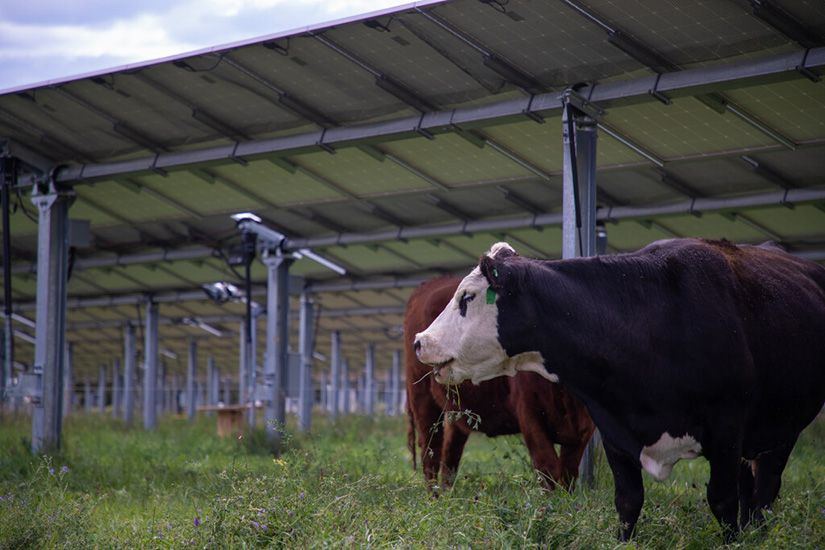

Clockwise from top left: Native prairie grows beneath solar panels at the Aurora Solar Project in Minnesota. Photo by Dennis Schroeder, NREL; cows graze under solar panels at Jack’s Solar Garden in Colorado. Photo by Joe DelNero, NREL; autumn leaves at the Denver Botanic Gardens agrivoltaics facility (solar installation in the background). Photo by Josh Bauer, NREL; beekeeper Jim Degiovanni inspects hives outside IMS Solar, a pollinator-friendly agrivoltaics site in Minnesota. Photo by Dennis Schroeder, NREL
The above stories provide just a snapshot of all the amazing research that happened at NREL throughout 2024. Visit our News and Features webpage to discover more ways that NREL researchers are advancing the science, development, commercialization, and deployment of renewable energy and energy efficiency technologies.
Last Updated May 28, 2025
